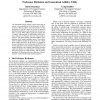Free Online Productivity Tools
i2Speak
i2Symbol
i2OCR
iTex2Img
iWeb2Print
iWeb2Shot
i2Type
iPdf2Split
iPdf2Merge
i2Bopomofo
i2Arabic
i2Style
i2Image
i2PDF
iLatex2Rtf
Sci2ools
AAAI
2006
2006
Preference Elicitation and Generalized Additive Utility
Any automated decision support software must tailor its actions or recommendations to the preferences of different users. Thus it requires some representation of user preferences as well as a means of eliciting or otherwise learning the preferences of the specific user on whose behalf it is acting. While additive preference models offer a compact representation of multiattribute utility functions, and ease of elicitation, they are often overly restrictive. The more flexible generalized additive independence (GAI) model maintains much of the intuitive nature of additive models, but comes at the cost of much more complex elicitation. In this article, we summarize the key contributions of our earlier paper (UAI 2005): (a) the first elaboration of the semantic foundations of GAI models that allows one to engage in preference elicitation using local queries over small subsets of attributes rather than global queries over full outcomes; and (b) specific procedures for Bayesian preference el...
AAAI 2006 | Bayesian Preference Elicitation | Intelligent Agents | Preference Elicitation | Preferences |
| Added | 30 Oct 2010 |
| Updated | 30 Oct 2010 |
| Type | Conference |
| Year | 2006 |
| Where | AAAI |
| Authors | Darius Braziunas, Craig Boutilier |
Comments (0)

